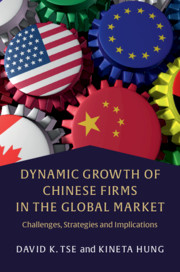Book contents
- Dynamic Growth of Chinese Firms in the Global Market
- Dynamic Growth of Chinese Firms in the Global Market
- Copyright page
- Contents
- Figures
- Tables
- 1 Introduction
- 2 China’s Economic Rise and Global Footprints of Chinese Firms
- 3 Globalisation of Chinese Firms Using Existing Paradigms
- 4 Globalisation of Chinese Firms Using New Paradigms
- 5 Challenges and Failures
- 6 Product Images and Market Acceptance of Chinese-Made Products
- 7 Corporate Social Responsibility
- 8 Managing National Image
- 9 China’s Technological Competence, Trade Relations, and Economic Co-operation
- 10 Holistic Conclusion through a Futuristic Lens
- Index
- References
7 - Corporate Social Responsibility
Published online by Cambridge University Press: 05 February 2020
- Dynamic Growth of Chinese Firms in the Global Market
- Dynamic Growth of Chinese Firms in the Global Market
- Copyright page
- Contents
- Figures
- Tables
- 1 Introduction
- 2 China’s Economic Rise and Global Footprints of Chinese Firms
- 3 Globalisation of Chinese Firms Using Existing Paradigms
- 4 Globalisation of Chinese Firms Using New Paradigms
- 5 Challenges and Failures
- 6 Product Images and Market Acceptance of Chinese-Made Products
- 7 Corporate Social Responsibility
- 8 Managing National Image
- 9 China’s Technological Competence, Trade Relations, and Economic Co-operation
- 10 Holistic Conclusion through a Futuristic Lens
- Index
- References
Summary
Chinese firms have a poor history of questionable practices that have caused various public relations crises in domestic and international markets. This chapter examines the development of corporate social responsibility (CSR) in Chinese firms, including their drivers and their current state. To prevent Chinese firms from having profit maximisation as their sole objective, the Chinese government positioned CSR as an area central to the country’s stability and future growth. It has also developed guidelines for firms in line with the United Nations Global Compact and encouraged firms to adopt them in their corporate policies and activities. The chapter ends by examining the CSR practices adopted by Huawei, a major Chinese firm, in its overseas operations, including those in Africa.
Keywords
- Type
- Chapter
- Information
- Dynamic Growth of Chinese Firms in the Global MarketChallenges, Strategies and Implications, pp. 123 - 145Publisher: Cambridge University PressPrint publication year: 2020



